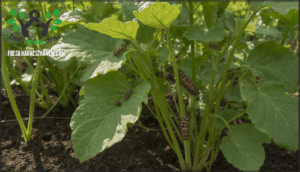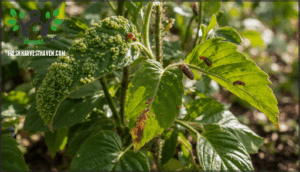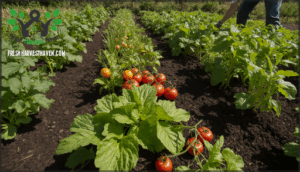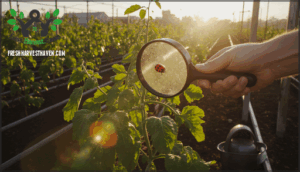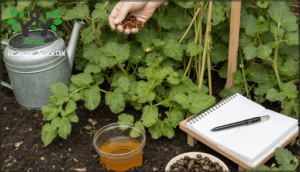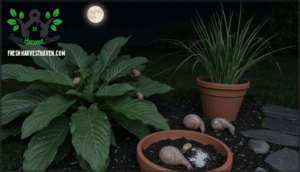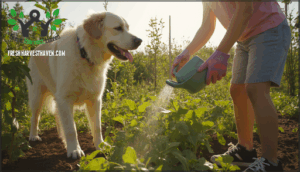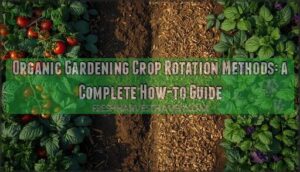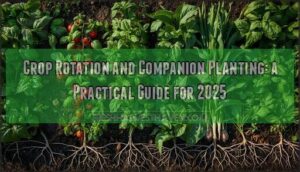This site is supported by our readers. We may earn a commission, at no cost to you, if you purchase through links.
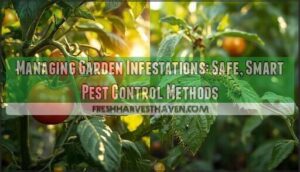
Garden infestations don’t announce themselves with warning signs; they escalate from a few curious visitors to a full-scale invasion while you’re busy with other tasks. The difference between minor pest damage and losing an entire season’s harvest often comes down to recognizing early symptoms and responding with targeted, effective strategies.
Managing garden infestations requires understanding both your adversaries and the ecological relationships that keep pest populations in check naturally.
Table Of Contents
- Key Takeaways
- Signs Your Garden Has a Pest Problem
- Most Common Types of Garden Pests
- Preventing Garden Infestations
- Daily Maintenance and Monitoring Tips
- Integrated Pest Management Strategies
- Natural and Organic Pest Control Methods
- Managing Slugs and Snails Effectively
- Safe Pest Management for Families and Pets
- Frequently Asked Questions (FAQs)
- How do I get rid of pests in my garden?
- Are pests Ruining Your Garden?
- Should you use pest repellent in your garden?
- How do gardeners control pests?
- How to reduce insect pests during a walk?
- Should you kill all bugs in your garden?
- What are the three types of pests in a garden?
- How can a gardener control insect damage?
- How do pests affect your garden?
- How to get rid of bug infestation in garden?
- Conclusion
Key Takeaways
- Garden pest management relies on early detection through daily monitoring—spotting damage patterns like yellowing leaves, chewed holes, or sticky residue before minor problems escalate into full-blown infestations that can destroy an entire season’s harvest.
- Integrated pest management combines multiple strategies (cultural controls, physical barriers, biological predators, and selective chemical use as a last resort) to create a balanced ecosystem that naturally suppresses pests without eliminating all insects or relying heavily on toxic pesticides.
- Prevention through soil health, crop rotation, companion planting, and plant diversity creates gardens that naturally resist infestations by disrupting pest life cycles, confusing host-finding behavior, and supporting beneficial predator populations that keep destructive pests in check.
- Safe, organic control methods—including handpicking, water sprays, beneficial nematodes, insecticidal soaps, and physical barriers like copper tape—effectively manage common garden pests (aphids, beetles, caterpillars, slugs) without introducing risks to children, pets, or beneficial wildlife.
Signs Your Garden Has a Pest Problem
Your garden sends clear signals when pests move in. Recognizing these early warning signs helps you act before minor problems turn into full-blown infestations.
Here’s what to watch for during your regular garden inspections.
Leaf Damage and Distortion
When your garden’s leaves start looking more chewed up than a dog toy, it’s time to investigate what’s munching on your plants. Identifying damage patterns helps you pinpoint the culprit.
Aphids and spider mites cause yellowing between leaf veins—a condition called chlorosis—while their feeding drains essential nutrients. You’ll spot leaf miners by their distinctive serpentine trails etched across foliage. Caterpillars leave irregular, ragged holes that differ from disease spots.
Pest excrement, sticky honeydew residue, and webbing confirm insect activity. Don’t confuse pest damage with nutrient deficiencies or environmental stress; integrated pest management starts with accurate pest identification.
Wilting and Stunted Growth
Your plants might’ve plenty of water and sunlight, but if they’re wilting like day-old lettuce or growing at a snail’s pace, the real troublemaker could be lurking beneath the soil. Root damage from underground pests disrupts water uptake, creating water stress symptoms even in well-watered gardens. Here’s what to check during pest identification:
- Examine roots for grub damage or nematode galls
- Test soil for compaction issues affecting plant health
- Inspect for sap-sucking insects causing nutrient deficiency
- Look for leaf damage patterns indicating systemic problems
- Rule out fungal root rot versus pest damage
Accurate pest identification separates treatable infestations from environmental challenges.
Holes, Trails, and Tunnels
Nothing speaks louder than the physical evidence pests leave behind—holes punched through petals, silvery trails across your tomato leaves, or mysterious tunnels carved into your kale. Flea beetles create perfect circles, while caterpillars leave ragged edges with telltale frass identification nearby. Tunneling insects like leafminers draw meandering pathways through foliage.
Check soil disruption around stems—entry holes signal root damage from grubs or rodent pathways threatening your plant’s foundation.
Unusual Discoloration or Spots
When leaves start showing strange colors they weren’t born with—mottled yellows, rusty browns, or dark spots that spread like spilled ink—you’re looking at evidence that something’s feeding, breeding, or infecting beneath the surface. Spot identification helps separate pest damage from disease mimicry or nutrient deficiencies that produce similar symptoms. Aphids create yellowing clusters, while viral infections cause mosaic patterns you won’t see with environmental stressors alone. Effective pest identification means examining both sides of affected leaves—circular brown spots with pest frass underneath confirm insect activity, while irregular holes suggest different culprits altogether.
Critical discoloration patterns requiring immediate action:
- Stippled yellow speckling across leaf surfaces indicates spider mites extracting chlorophyll
- Bronze or silvery patches with tiny black dots reveal thrips causing cellular leaf damage
- Concentric rings or target-shaped spots suggest fungal disease following initial pest wounds
- Interveinal chlorosis with green veins points to nutrient deficiencies from root-feeding pests blocking uptake
Presence of Webbing or Tents
If you’ve spotted silky strands wrapping around stems or strange tent-like structures appearing overnight in your trees, what exactly built them—and should you be worried? Recognizing these silk structures allows proper webworm control through targeted interventions—managing garden infestations starts with accurate webbing identification.
Spider mites spin fine webbing on leaf undersides while extracting plant fluids, whereas tent caterpillars construct communal silk tents in branch crotches for shelter between feeding periods.
| Pest Type | Silk Structure Appearance | Primary Target Plants |
|---|---|---|
| Red spider mite | Fine, nearly invisible webs coating leaf undersides | Tomatoes, beans, roses |
| Tent caterpillar | Large, visible white tents in tree forks | Fruit trees, ornamentals |
| Fall webworm | Loose webs enclosing branch tips and foliage | Deciduous trees, shrubs |
Most Common Types of Garden Pests
Not every insect in your garden is a threat, but certain pests show up so reliably that you’ll want to recognize them on sight. From tiny aphids clustering on tender stems to night-roaming slugs leaving silver trails, these common culprits cause the bulk of garden damage.
Here’s a breakdown of the pest types you’re most likely to encounter and what makes each one problematic.
Aphids and Sap-Sucking Insects
Aphids rank among your garden’s most prolific invaders, reproducing astonishingly fast through parthenogenesis to create dense colonies that can stunt plant growth by up to 80%. These tiny sap-sucking insects pierce plant tissues and excrete honeydew, which attracts ants and fosters sooty mold growth on leaves. You’ll find them clustered on tender new growth, often protected by ants that farm them for their sweet secretions—a fascinating example of ant mutualism.
One method to control them involves using reflective mulches to repel aphids. Here’s what you need to know:
- Aphid lifecycle completes in just 7-10 days under warm conditions
- Honeydew effects include sticky residue and reduced photosynthesis
- Sooty mold develops on honeydew, blackening foliage
- Natural predators like ladybugs and lacewings consume hundreds daily
- Insecticidal soaps, horticultural oils, and neem oil provide effective organic control
Target aphids early before colonies explode—prevention beats intervention every time.
Beetles and Leaf Chewers
Across your garden beds, beetles stage some of the most visible raids—chewing irregular holes through foliage and leaving behind telltale skeletonized leaves. Beetle identification matters because different species target specific crops and respond to distinct control methods. You’ll recognize Japanese beetles by their metallic bronze shells and their habit of congregating on rose petals and grapevines, while striped cucumber beetles zero in on squash family plants, spreading bacterial wilt as they feed.
Understanding chewing patterns helps with damage prevention:
- Flea beetles create tiny shothole perforations in brassicas and eggplants
- Colorado potato beetles strip potato and tomato plants systematically
- Mexican bean beetles skeletonize bean leaves from underneath
Natural predators like spined soldier bugs and parasitic wasps provide biological beetle control, while handpicking larvae during morning inspections removes future generations before they mature. Targeted sprays containing Bacillus thuringiensis work effectively against beetle larvae without harming beneficial insects, giving you precise control over leaf damage.
Caterpillars and Larvae
You’ll spot caterpillars munching their way through leaves—these soft-bodied larvae represent the immature stage of moths and butterflies in their life cycles. Caterpillar identification matters for control methods: tomato hornworms devastate solanaceous crops, while cabbage butterflies target brassicas with voracious appetite.
Handpicking larvae during morning inspections removes pests before they cause extensive larval damage, and Bacillus thuringiensis (Bt) provides targeted biological control without harming butterfly gardens or beneficial species.
Slugs, Snails, and Mollusks
These nocturnal feeders emerge after dark, leaving behind silvery mucus trails and ragged holes in your most prized vegetables and ornamentals. You’ll recognize snail damage by the irregular chewing patterns on leaves, stems, and even ripening fruit—unlike caterpillars, mollusks usually feed from leaf edges inward.
Effective slug lifecycle disruption combines multiple natural pest control approaches:
- Copper tape creates electrical barriers that repel slugs and snails on contact
- Beer traps attract and drown adult mollusks without bait toxicity concerns
- Iron phosphate-based baits eliminate populations while remaining safe for natural predators like ground beetles
- Crushed eggshells or diatomaceous earth deter movement through abrasive barriers
These organic pest control methods provide safe pest management without harming beneficial wildlife or pets that patrol your garden.
Root and Soil-Dwelling Pests
Below the surface, root-dwelling grubs, wireworms, and root aphids silently destroy your plants’ foundation before symptoms appear above ground. These soil insects cause root damage that manifests as unexplained wilting, stunted growth, and yellowing foliage—signs that often puzzle gardeners until they inspect below the soil line.
Effective grub management starts with beneficial nematodes applied during peak larval activity, while soil solarization eliminates wireworm populations by heating soil under clear plastic for 4-6 weeks.
You’ll protect soil health through crop rotation that disrupts pest life cycles, and nematode control strategies targeting specific root feeders without harming earthworms or mycorrhizae. Regular inspection of root systems during transplanting reveals hidden infestations early.
Preventing Garden Infestations
Prevention is always your best defense against garden pests, and it starts long before you spot the first sign of damage. By making smart choices about what you plant, how you arrange it, and how you care for your soil, you can build a garden that naturally resists infestations.
Here are five proven strategies that’ll help you stop pests before they become a problem.
Choosing Resistant Plant Varieties
When you’re planting with prevention in mind, choosing the right varieties can save you months of pest battles down the road. Disease-resistant varieties aren’t just marketing hype; they’re bred specifically to withstand common threats. Look for seed packets labeled with resistance codes—"VF" indicates protection against verticillium and fusarium wilt, while "TMV" means tobacco mosaic virus resistance.
You’ll find pest tolerance built into many modern cultivars, though some heirloom varieties also offer surprising resilience against local pests.
Crop Rotation and Companion Planting
Beyond choosing resistant varieties, you can break pest cycles through strategic crop planning and companion crops. Rotation benefits become clear when you move plant families annually—three-year cycles prevent soil-dwelling larvae from finding their hosts. Your planting design should pair compatible species: nasturtiums lure aphids away from vegetables, while aromatic herbs create pest confusion. This approach strengthens soil health naturally.
- Rotate nightshades, brassicas, and legumes to disrupt beetle life cycles
- Plant garlic between rose bushes to repel Japanese beetles
- Use your Companion Chart to map beneficial pairings each season
Maintaining Healthy Soil
Strong, living soil acts as your garden’s first line of defense—when beneficial microbes outnumber harmful ones, pests can’t gain a foothold. Healthy soil with 5% organic matter creates a nutrient balance that strengthens plant immunity while improving water retention and erosion control.
Regular soil composition improvements don’t just feed your plants—they create an underground network that naturally suppresses harmful organisms before infestations begin.
| Soil Health Practice | Pest Protection Result |
|---|---|
| Add 2–3 inches compost annually | 150% more beneficial microbial life |
| Maintain pH 6.0–7.5 | 70% fewer fungal pathogens |
| Incorporate cover crops | 40% reduction in root pests |
| Apply biochar amendments | 50% less disease severity |
Using Physical Barriers and Row Covers
You can build a fortress around your garden without pouring concrete or stringing barbed wire—simple fabrics and screens do the job just as well. Floating row covers offer effective pest exclusion while allowing 70–90% light transmission for photosynthesis. Installation techniques matter: drape barrier materials loosely over hoops, securing edges with soil or landscape staples to prevent gaps where insects enter.
These physical controls create microclimate control that warms soil 2–4°F earlier in spring while blocking aphids, flea beetles, and cabbage butterflies.
For crop protection, use mechanical controls like copper tape around raised beds or mesh cloches over individual plants—you’re creating obstacles pests won’t cross.
Encouraging Plant Diversity
Mixing different plant species throughout your garden beds transforms your garden into a complex puzzle that pests struggle to solve. A diverse ecosystem confuses pests searching for their preferred host plants, while also supporting natural pest management through habitat creation. Integrated pest management relies on this ecological principle—when you create varied plant communities, you’re boosting soil health and pest resistance simultaneously.
To implement this approach, consider the following strategies:
- Plant native species alongside vegetables to attract pollinators and beneficial predators
- Alternate plant heights and textures to disrupt pest movement patterns
- Include perennials with annuals to maintain year-round garden ecosystem stability
Daily Maintenance and Monitoring Tips
Daily maintenance isn’t about adding hours to your schedule—it’s about making observation a habit. A quick walk through your garden each day allows you to spot trouble before it spirals into a full-blown infestation.
Here’s what to focus on during your routine checks.
Early Detection Through Daily Walks
A single overlooked aphid colony this morning can become a full-blown infestation by week’s end, which is why your daily garden walk matters more than you might think.
Walk timing matters—early mornings reveal fresh damage and active pests before heat drives them into hiding. Bring magnifying tools to examine leaf undersides where tiny insects cluster. Record photos of suspicious spots for pest ID later, building your visual reference library.
Through consistent pest scouting, you’ll recognize action thresholds—the point where pest monitoring shifts from observation to intervention. This daily maintenance routine transforms casual strolls into strategic early detection sessions that protect your entire garden.
Checking for Pest Damage and Disease
Every leaf tells a story if you know how to read the clues—and spotting trouble before it spreads starts with understanding what healthy plants shouldn’t look like. During your monitoring frequency checks, examine plants systematically for early signs of trouble.
Disease symptoms often appear alongside pest damage, so pest identification requires careful damage assessment of multiple indicators:
- Yellowing leaves with stippled patterns suggesting sucking insects
- Wilted foliage despite proper watering indicating root feeders
- Chewed margins with irregular holes from leaf-eating beetles
- Sticky residue coating surfaces beneath aphid colonies
- Powdery spots signaling fungal infections alongside pest activity
These signs of garden pest problems demand immediate attention before plant diseases take root.
Immediate Removal of Pests
When a pest appears on your plant, think of it like spotting a crack in your windshield—wait too long, and that small problem spreads into something you can’t ignore. Immediate removal during your garden walk stops reproduction cycles before populations explode.
Handpicking pests like Colorado potato beetles or Japanese beetles works remarkably well for manual removal. For aphids, try spraying techniques with a strong water blast to dislodge colonies. Trapping methods and vacuuming insects off foliage provide additional control for mobile pests. Keep a container ready during pest scouting and removal sessions—swift action protects your plants and reduces the need for chemical interventions later.
| Pest Type | Immediate Action | Follow-Up Method |
|---|---|---|
| Aphids | Handpicking clusters or water spray | Insecticidal soap application |
| Caterpillars | Manual removal by hand | Organic sprays if needed |
| Beetles | Physical collection into container | Neem oil for remaining eggs |
Keeping Accurate Garden Records
Think of your garden journal as the black box recorder for your growing season—without it, you’re flying blind every time a pest shows up. Record pest identification findings during daily maintenance and monitoring walks, noting dates, locations, and treatment methods used.
Spray application logs and pest lifecycle tracking create data-driven decisions for next season’s prevention strategies. Document weather conditions alongside pest scouting observations—humidity spikes often trigger aphid explosions.
Your garden records reveal which controls actually worked, turning guesswork into yield data analysis that protects your plants year after year. Record keeping benefits extend beyond immediate control, building a knowledge base that makes you a better grower.
Integrated Pest Management Strategies
Integrated pest management combines multiple approaches to keep your garden healthy without relying on chemicals alone. This strategy works because it tackles pest problems at every stage—from prevention to intervention—using the safest, most effective methods available.
The following sections outline five core IPM practices that work together to protect your plants while maintaining a balanced ecosystem.
Cultural Controls and Garden Practices
Your garden’s layout and daily routines are either working for you or quietly inviting trouble. Cultural controls—like proper watering, plant spacing, and regular pruning—form the foundation of integrated pest management. When you avoid overfertilizing, you prevent tender growth that attracts pests.
Healthy plants grown through these garden practices resist infestations naturally. Crop rotation disrupts life cycles, while sanitation removes hiding spots. Together, these strategies maintain garden health by creating conditions pests can’t exploit.
Mechanical and Physical Controls
While cultural practices set the stage for success, sometimes pests need a more direct intervention—one that doesn’t involve sprays or predators. Mechanical controls and physical barriers give you hands-on power to stop infestations before they spread. Row covers protect seedlings from flying insects, while barrier methods like copper tape repel slugs on contact. Trapping techniques capture beetles and earwigs overnight, and hand removal works exceptionally well for larger caterpillars you can spot during inspections.
Four mechanical strategies that deliver results:
- Vacuuming pests from leaves removes aphids instantly
- Soil solarization heats soil to kill larvae and eggs
- Fine mesh barriers exclude cabbage moths completely
- Sticky traps monitor and capture whiteflies effectively
These methods require minimal investment but demand your attention and consistency.
Biological Controls With Natural Predators
Biological controls with natural predators form the backbone of integrated pest management. Naturally occurring predators reduce pest numbers by an average of 73% across garden systems, and biocontrol interventions cut pest abundance by 63% compared to no control. Ladybugs and lacewings consume aphids while parasitic wasps target caterpillars—your garden practically runs its own security detail.
Natural enemy abundance jumps 43% higher after biocontrol implementation versus synthetic pesticides, and these beneficial insects respond directly to habitat complexity. Plant diverse flowers to boost predator diversity and prey removal rates. Biocontrol interventions also maintain natural enemy populations.
This economic efficiency pays off: biocontrol increases technical efficiency scores and reduces damage by over 50% across multiple pest taxa.
Judicious Use of Chemical Controls
Chemical pesticides serve as your last line of defense once cultural practices and biological controls have reached their limits. Select EPA-registered products with targeted application profiles, applying minimal dosage only to affected areas.
Proper safety practices—gloves, masks, and timing—reduce environmental hazards while systemic insecticides reach hidden pests.
Rotate chemical controls regularly to prevent pesticide resistance, and always follow label instructions for environmental impact mitigation.
Monitoring and Record Keeping
Once chemical pesticides have done their job, consistent monitoring becomes your feedback loop—showing you what’s working, what’s failing, and where your next pest pressure will likely emerge. Daily maintenance and monitoring allow you to track pest identification patterns and conduct damage assessments accurately. Your garden records should capture:
- Pest population counts and species – Note numbers during daily walks for evaluating infestation extent.
- Control effectiveness ratings – Document which treatments reduced specific problems.
- Environmental correlations – Track weather and soil moisture alongside pest activity.
Data analysis of these long-term trends reveals which interventions deliver results, helping you improve your approach season after season. Identifying pests early and tracking outcomes gives you real control over your garden’s health.
Natural and Organic Pest Control Methods
When chemicals aren’t your first choice, natural and organic methods give you real control over garden pests without compromising safety. These techniques work with your garden’s ecosystem rather than against it, protecting beneficial insects while targeting the troublemakers.
Here’s how you can tackle infestations using methods that are both effective and environmentally sound.
Handpicking and Trapping Pests
Sometimes the simplest solution delivers the most satisfying results—plucking pests off your plants by hand costs nothing and works immediately. Manual pest control works best for larger insects like hornworms and Japanese beetles during early morning hours when they’re sluggish. Drop collected pests into soapy water for quick disposal.
Bait selection matters for trap effectiveness—beer attracts slugs while pheromone lures target specific species. Clean tools between uses for proper tool sanitation, preventing disease spread. These cultural controls integrate seamlessly into ethical pest management strategies.
| Pest Control Method | Best Target Pests |
|---|---|
| Handpicking | Hornworms, beetles, caterpillars |
| Sticky traps | Whiteflies, aphids, fungus gnats |
| Pitfall traps | Ground beetles, slugs, earwigs |
| Copper barriers | Slugs, snails |
| Row covers | Flying insects, flea beetles |
Strong Water Spray Techniques
A strong blast from your garden hose can knock soft-bodied insects off plants just as effectively as reaching for a chemical spray bottle. Target aphids and spider mites on leaf undersides using adjustable nozzle types that let you control spray pressure—you don’t want to damage delicate foliage. This technique works best in early morning when pests are less active, and it’s one of the simplest pest control methods available.
Effective water spray techniques include:
- Adjust spray pressure based on plant sensitivity—tender seedlings need gentler streams than established shrubs
- Check your water source temperature; cold water works better than warm for dislodging insects
- Incorporate technique variations by angling sprays upward to reach hidden colonies where pests congregate
Organic Sprays and Dusts
If you’ve ever felt like your garden needs a little backup without bringing out the big guns, organic sprays and dusts might be exactly what you’re looking for. Neem oil disrupts insect feeding and reproduction, making it particularly effective against aphids and whiteflies. Insecticidal soap penetrates soft-bodied pests’ membranes, while pyrethrin sprays—derived from chrysanthemums—offer quick knockdown of flying insects. Diatomaceous earth works mechanically, creating microscopic cuts that dehydrate crawling pests like beetles and slugs.
You can even prepare homemade solutions using garlic or hot pepper for gentle deterrence. Apply these organic pest control methods during cooler hours to prevent leaf burn and increase contact time.
Beneficial Nematodes and Microbials
Microscopic warriors do the heavy lifting where organic sprays can’t reach—deep in your soil. Beneficial nematodes and microbials work underground, targeting pest larvae before they mature into crop-damaging adults. These biological controls integrate seamlessly into IPM compatibility systems, supporting soil health and beneficial insects while maintaining natural predators’ populations. With over 3,000 microbial biopesticide species registered globally and nematodes showing 75–95% pest reduction rates, you’re enlisting proven allies with outstanding biopesticide safety profiles and zero groundwater contamination.
- Steinernema feltiae achieves 95% control of fungus gnats in greenhouse trials
- Heterorhabditis bacteriophora reduces Japanese beetle grubs by 58% in favorable soil
- Bacillus thuringiensis products dominate 75–95% of microbial pest control markets
- Nematode application works best in moist, clay-rich soils with proper timing
- Microbial diversity decomposes rapidly, leaving zero persistent residues on crops
Companion Planting for Repellence
Strategic plant partnerships turn neighboring vegetables and flowers into living shields that confuse, repel, or redirect hungry insects. Pest-repelling herbs like basil and rosemary use scent masking to hide your tomatoes from aphids, while marigolds release allelopathic effects that deter nematodes.
Trap cropping with nasturtiums draws cucumber beetles away from valuable crops. These planting guilds combine companion planting principles with natural pest control, forming cultural controls that protect garden pests without synthetic chemicals—giving you mastery over pest control through strategic design.
Managing Slugs and Snails Effectively
Slugs and snails can devastate a garden overnight, chewing ragged holes through tender leaves and seedlings. These mollusks thrive in moist conditions and hide during the day, making them tricky to catch in action.
Here are five proven methods to protect your plants and keep these pests under control.
Nighttime Collection and Removal
Slugs and snails leave their hiding spots around dusk, which means timing your garden patrol after sunset gives you the upper hand. Nocturnal Pest ID becomes straightforward with best headlamps illuminating their slime trails and feeding activity. Manual removal through handpicking offers immediate population control—a mechanical control method that’s both effective and chemical-free.
Essential nighttime collection techniques:
- Timing is key: patrol between 9 p.m. and midnight when activity peaks
- Equipment: use headlamps or flashlights to spot pests on leaves and soil
- Disposal methods: drop collected pests into soapy water or relocate far from your garden
- Ethical considerations: choose humane removal that aligns with your pest control philosophy
This cultural control approach integrates seamlessly into your routine pest management strategy.
Barriers and Copper Tape
Copper tape and physical barriers stop these mollusks in their tracks without the need for poisons or nightly patrols. When slugs or snails encounter copper, their slime reacts with the metal, creating an unpleasant sensation that turns them away. Install 4-inch copper strips around raised beds or apply self-adhesive tape to pot rims for effective pest exclusion. These barrier materials blend with garden aesthetics while providing reliable organic pest control year-round.
- Protect seedlings immediately: copper effectiveness kicks in the moment vulnerable plants emerge
- Watch your transplants thrive: installation methods create safe zones where young plants establish without constant slug damage
- Reclaim your garden’s beauty: barriers restore confidence that your careful work won’t disappear overnight
Traps and Baits
Deploying targeted traps and strategic baits gives you a hands-off way to reduce pest populations while you focus on the rest of your garden. Beer traps lure slugs and snails effectively—bury shallow containers so the rim sits at soil level for easy access.
Iron phosphate baits provide organic pest control without bait toxicity concerns for children or pets. Position traps near damaged plants where pest attraction runs highest, checking trap placement every few days.
Bait longevity decreases with rain, so trap maintenance matters for consistent pest management results.
Reducing Moisture and Hiding Spots
When you cut off their favorite hideouts and dry up their damp havens, slugs and snails lose the upper hand in your garden. Start with proper drainage—amend clay soils with compost to prevent waterlogged conditions. Thin mulch layers to two inches max, since thick mulching creates ideal shelter.
Regular pruning techniques improve air circulation around foliage while debris removal eliminates hiding spots under boards, rocks, and plant debris. Morning watering gives soil time to dry before nightfall when these pests emerge.
Safe Organic Deterrents
Beyond cutting off moisture and hiding spots, you can deploy natural materials that actively repel slugs and snails without introducing chemicals into your garden. These organic pest control methods protect beneficial insects while creating effective barriers:
- Diatomaceous earth forms microscopic sharp edges that deter soft-bodied pests without harming soil health
- Copper strips generate mild electrical charges that repel mollusks on contact
- Crushed eggshells and coffee grounds create abrasive natural barriers around vulnerable plants
Companion planting with herbs like rosemary strengthens natural pest control alongside insecticidal soap or neem oil applications when needed.
Safe Pest Management for Families and Pets
When you’re managing pests in your garden, safety comes first—especially if children or pets spend time outdoors. The goal is to control infestations without introducing harmful chemicals that could pose risks to your family or the environment.
Here’s how to keep your garden healthy and your loved ones safe.
Avoiding Toxic Chemical Pesticides
Toxic chemical pesticides pose serious health risks you shouldn’t overlook. Long-term exposure can cause neurological problems, endocrine disruption, and even cancer for your family and pets.
Instead, embrace organic pest control methods and integrated pest management strategies that rely on beneficial insects, biopesticide effectiveness, and natural pest control techniques.
These organic alternatives reduce environmental persistence while supporting sustainable gardening practices, and IPM adoption has proven effective without compromising your family’s safety.
Choosing Pet-Friendly Solutions
Your four-legged companions deserve the same protection from pests that you’re trying to keep away from your plants. Safe pesticides like insecticidal soap and neem oil won’t harm dogs or cats during natural pest control applications. These organic pest control methods support beneficial insects while eliminating harmful invaders through effective pest management.
Consider these DIY solutions that balance plant protection with pet safety:
- Natural repellents such as diatomaceous earth create barriers against slugs without toxic residues that threaten animals
- Companion planting with marigolds and lavender provides pest control through natural plant chemistry rather than dangerous compounds
- Physical barriers including copper tape and row covers offer pet exclusion zones while preventing insect damage mechanically
Understanding plant toxicity helps you avoid varieties dangerous to pets while maintaining strong pest management strategies.
Proper Storage and Application of Controls
Keeping pest treatments stored correctly and applying them with care can mean the difference between a thriving garden and an accidental hazard. Lock all chemical controls, horticultural oils, soaps, and insecticides in their original containers away from living spaces. Control degradation accelerates when products face temperature extremes, so choose cool, dry locations.
Always wear protective gear during pesticide application—gloves, eye protection, and long sleeves prevent skin contact with concentrates.
| Control Type | Storage Duration | Application Timing |
|---|---|---|
| Insecticidal soaps | 2-3 years | Early morning/evening |
| Horticultural oils | 1-2 years | Dormant or growing season |
| Chemical insecticides | Check label expiration | Calm, dry conditions |
Follow mixing ratios precisely to avoid plant damage or ineffective treatments. Safe disposal through hazardous waste programs protects groundwater from contamination.
Educating Family on Garden Safety
Teaching everyone in your household about garden pest safety turns potential hazards into opportunities for learning and shared stewardship of your outdoor space. When children grasp which creatures help your plants and which harm them, they become partners in safe pest management for families rather than bystanders.
Start with hands-on lessons that build confidence—show them aphids clustering on rose stems, then demonstrate handpicking techniques that require no chemicals.
Family IPM succeeds when everyone knows the basics:
- Identifying friend from foe – Point out ladybugs, lacewings, and other beneficial insects versus destructive pests
- Proper handwashing protocols – Emphasize thorough cleaning after any garden contact or natural pest control methods
- Child-safe pesticides and pet-friendly gardens – Explain which organic pest control options work without risk
- Garden education on safe application – Teach dilution ratios and timing for even the mildest treatments
- Emergency response – Establish clear steps if someone touches unfamiliar insects or substances
Regular garden walks transform pest control advice into practical skills your family retains.
Long-Term Sustainable Practices
Sustainable pest control isn’t a quick fix—it’s a long-term investment that pays dividends season after season by reducing chemical dependence and strengthening your garden’s natural defenses. Crop rotation disrupts pest life cycles while improving soil health, and regular compost additions build the kind of healthy soil that fosters plant immunity.
You’ll encourage beneficial insects through habitat creation—diverse flowering plants attract natural predators that patrol your beds year-round.
Integrated pest management combines these strategies with water conservation and waste reduction, creating biodiversity support that makes chemical interventions rare. That’s how sustainable gardening works.
Frequently Asked Questions (FAQs)
How do I get rid of pests in my garden?
Daily scouting stops pest control problems before they spiral. Handpick visible invaders, deploy companion plants like marigolds for natural pest control methods, and spray neem oil on aphids.
Proper spacing promotes airflow, preventing pest infestations through integrated pest management without harsh chemicals.
Are pests Ruining Your Garden?
Chewed leaves, yellowing foliage, and sticky residue signal pest activity requiring damage assessment and pest identification.
Understanding which garden pests are present—from aphids to beetles—guides your pest control methods, helping you deploy integrated pest management strategies and prevention tips to protect plants effectively.
Should you use pest repellent in your garden?
Repellent effectiveness depends on the pest and product. Natural pest control methods like companion planting offer environmental benefits, while organic pest control options minimize human safety concerns.
Integrated pest management balances cost analysis with plant health needs.
How do gardeners control pests?
Gardeners rely on integrated pest management techniques that combine cultural methods, biological controls, and organic solutions.
You’ll scout daily for early detection, handpick visible pests, improve airflow through strategic spacing, and deploy natural pest control methods like beneficial insects or neem oil when needed.
How to reduce insect pests during a walk?
Inspect plants closely on your daily garden walk, looking for visual cues like chewed leaves or pest clusters.
Handpicking during these walks stops small infestations fast—early detection through targeted removal keeps your garden healthy without chemicals.
Should you kill all bugs in your garden?
No—not all bugs are pests. Beneficial insects like ladybugs and lacewings serve as natural predators in your garden ecosystem.
Integrated pest management encourages selective control, targeting only harmful species while maintaining pest tolerance and ecosystem balance within IPM thresholds.
What are the three types of pests in a garden?
Three main pest categories threaten gardens: insect pests like aphids and beetles that chew or suck plant tissue; animal pests such as rodents that consume roots and stems; and plant diseases caused by fungi, bacteria, and viruses.
Identifying damage patterns helps you understand pest lifecycles and target pest infestation effectively.
How can a gardener control insect damage?
The best defense seems like overkill—until pests arrive. Control insect damage through integrated pest management strategies combining cultural practices, biological controls with beneficial insects and natural predators, and safe pesticides like insecticidal soap or Bacillus thuringiensis (Bt) following thorough damage assessment.
How do pests affect your garden?
Pests disrupt your garden’s ecosystem by extracting essential nutrients through sap-sucking, chewing foliage, and damaging roots. This insect infestation weakens plant health, stunts growth, and invites disease.
Identifying garden pests early prevents aesthetic degradation and economic consequences from reduced yields.
How to get rid of bug infestation in garden?
Scout your garden daily to identify pests early, then respond with integrated pest management.
Handpick visible bugs, deploy natural predators like ladybugs, apply organic solutions such as neem oil, and remove infested debris to stop spread.
Conclusion
Next season’s success depends on the systems you establish now. Managing garden infestations isn’t about achieving a sterile, pest-free environment—that’s neither possible nor desirable. Instead, you’re cultivating resilience through diverse plantings, healthy soil, and beneficial predators that keep destructive populations in check.
When problems arise, you’ll have the knowledge to respond strategically rather than reactively. Your garden becomes stronger not by eliminating every threat, but by building the ecological balance that makes devastating infestations unlikely in the first place.

